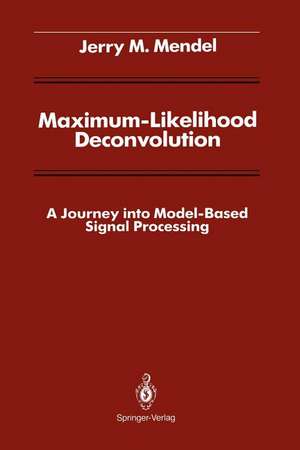Maximum-Likelihood Deconvolution: A Journey into Model-Based Signal Processing: Signal Processing and Digital Filtering
Autor Jerry M. Mendel C. S. Burrusen Limba Engleză Paperback – 17 sep 2011
Preț: 385.08 lei
Nou
Puncte Express: 578
Preț estimativ în valută:
73.71€ • 80.09$ • 61.96£
73.71€ • 80.09$ • 61.96£
Carte tipărită la comandă
Livrare economică 21 aprilie-05 mai
Preluare comenzi: 021 569.72.76
Specificații
ISBN-13: 9781461279853
ISBN-10: 1461279852
Pagini: 244
Ilustrații: XIV, 227 p.
Dimensiuni: 155 x 235 x 13 mm
Greutate: 0.35 kg
Ediția:Softcover reprint of the original 1st ed. 1990
Editura: Springer
Colecția Springer
Seria Signal Processing and Digital Filtering
Locul publicării:New York, NY, United States
ISBN-10: 1461279852
Pagini: 244
Ilustrații: XIV, 227 p.
Dimensiuni: 155 x 235 x 13 mm
Greutate: 0.35 kg
Ediția:Softcover reprint of the original 1st ed. 1990
Editura: Springer
Colecția Springer
Seria Signal Processing and Digital Filtering
Locul publicării:New York, NY, United States
Public țintă
ResearchCuprins
1 - Introduction.- 1.1 Introduction.- 1.2 Our Approach.- 1.3 Likelihood Versus Probability.- 1.4 Maximum-Likelihood Method.- 1.5 Comments.- 2 - Convolutional Model.- 2.1 Introduction.- 2.2 The Seismic Convolutional Model.- 2.3 Input.- 2.4 Channel Model IR (Seismic Wavelet).- 2.5 Measurement Noise.- 2.6 Other Effects.- 2.7 Mathematical Model.- 2.8 Summary.- 3 - Likelihood.- 3.1 Introduction.- 3.2 Loglikelihood.- 3.3 Likelihood Function.- 3.4 Using Given Information.- 3.5 Message for the Reader.- 3.6 Mathematical Likelihood Functions.- 3.7 Mathematical Loglikelihood Functions.- 3.8 Summary.- 4 - Maximizing Likelihood.- 4.1 Introduction.- 4.2 A Rationale.- 4.3 Block Component Search Algorithms.- 4.4 Mathematical Fact.- 4.5 Separation Principle.- 4.6 Update Random Parameters.- 4.7 Binary Detection.- 4.8 Update Wavelet Parameters.- 4.9 Update Statistical Parameters.- 4.10 Message for the Reader.- 4.11 Summary.- 5 - Properties and Performance.- 5.1 Introduction.- 5.2 Minimum-Variance Deconvolution.- 5.3 Detectors.- 5.4 A Modified Likelihood Function.- 5.5 An Objective Function.- 5.6 Marquardt-Levenberg Algorithm.- 5.7 Convergence.- 5.8 Entropy Interpretation.- 5.9 Summary.- 6 - Examples.- 6.1 Introduction.- 6.2 Some Real Data Examples.- 6.3 Minimum-Variance Deconvolution.- 6.4 Detection.- 6.5 Block Component Method.- 6.6 Backscatter.- 6.7 Noncausal Channel Models.- 6.8 Summary.- 7 - Mathematical Details for Chapter 4.- 7.1 Introduction.- 7.2 Mathematical Fact.- 7.3 Separation Principle.- 7.4 Minimum-Variance Deconvolution.- 7.5 Threshold Detector.- 7.6 Single Most-Likely Replacement Detector.- 7.7 Single Spike Shift Detector.- 7.8 SSS-SMLR Detector.- 7.9 Marquardt-Levenberg Algorithm.- 7.10 Calculating Gradients.- 7.11 Calculating Second Derivatives.- 7.12 Why vr Cannot be Estimated: Maximization of L or M is an Ill-Posed Problem.- 7.13 An Algorithm for ?.- 8 - Mathematical Details for Chapter 5.- 8.1 Introduction.- 8.2 MVD Filter Properties.- 8.3 Threshold Detector.- 8.4 Modified Likelihood Function.- 8.5 Separation Principle for P and Derivation of N from P.- 8.6 Why vr Cannot be Estimated: Maximization of P or N is not an Ill-Posed Problem.- 8.7 SMLR1 Detector Based on N.- 8.8 Quadratic Convergence of the Newton-Raphson Algorithm.- 8.9 Wavelet Identifiability.- 8.10 Convergence of Adaptive SMLR Detector.- 9 - Computational Considerations.- 9.1 Introduction.- 9.2 Recursive Processing.- 9.3 Summary.- References.




















